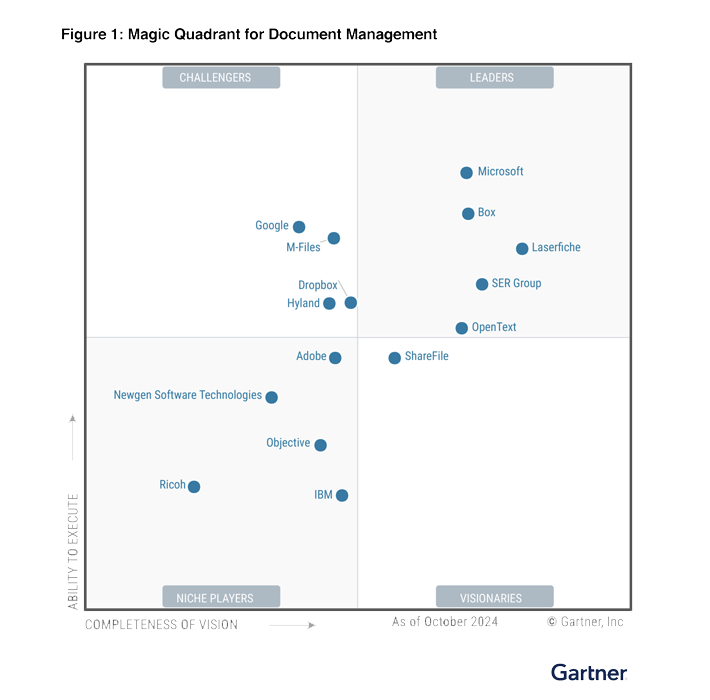What Is Document Management?
Document management is a set of practices that define how an organization manages, stores and tracks its documents.

Documents come in a wide variety of formats, from contracts and forms to images and emails. However, whatever form documents take, the principles of document management stay consistent. The common components of document management include:
- Storage: Provide a centralized location for documents that’s easy for authorized parties to access and search.
- Annotations: Add notes or comments to a document without needing to edit the document itself.
- Check-in and check-out: For critical documents, ensure that changes to documents by different users don’t overwrite each other, with a system that only allows for one party to make edits at a time.
- Version control: Track and record changes in real time so that with each new version of the document, you can view the edit history and roll back to a previous version if needed.
- Audit trails: Support your compliance initiatives by enabling authorized users to view a log of who has viewed or edited your documents, and when.
- Security and access control: Do everything possible to ensure access to documents is limited only to authorized parties. This is especially important in highly regulated industries.
These components play an important role in securing your organization’s information and making it useful to businesses.
What is the most important part of document management?
Although it may be up for debate, the most important aspects of document management are likely storage and organization. Proper organization and storage allows people to easily find content and information when they need it. You can expand these topics further to include things like metadata management, or even embrace more modern interpretations of the concept to include process automation and generative AI.
That said, the most important part of document management depends on your organization’s needs. We encourage you watch our webinar ECM 101: An Introduction to Document Management Features to help decide what aspect of document management is the most important.
Is document management a skill?
Although simple on the surface, document management is an important skill with a high ceiling for business professionals. The ideal document manager is:
- Organized and detail-oriented: sweats the small stuff so others don’t have to while also being able to see the big picture when creating a robust folder structure.
- Technically inclined: able to properly use a document management system and even troubleshoot when things aren’t going as planned.
- A good communicator: proficient in disseminating company policies and procedures when it comes to handling content.
How is document management useful?
Organizations and teams produce content at an ever-increasing rate — according to the Association for Intelligent Information Management (AIIM), “on average, organizations expect the volume of information coming into their organizations to grow from X to 4.5X over the next two years.”
To top it off, even with proper records retention, documents stay around a lot longer than they did in the days of paper.
When unaddressed, these challenges create:
- Siloed desktops.
- Cluttered network drives.
- Unorganized databases.
Subsequently, with information scattered between individuals and team this disorganized information can result in:
- Documents can become missing, outdated, unsecured, and in a worst-case scenario, even compromised by an unauthorized party.
- Employees could end up working with missing or incomplete information, hindering efficiency and productivity.
- In heavily regulated industries, improperly stored documents can be a compliance risk, and consequently a financial liability.
For these reasons, it’s important to select the right tools and technologies to take full advantage of them. This is where a document management system comes in.
What is an example of a document management system?
Laserfiche is a document management platform that’s flexible and easy-to-use, enabling organizations to:
- Store content with generated text and metadata to make them easier to search for later.
- Digitize physical documents for preservation and processing by digital systems.
- Utilize process automation organize content and route it to stakeholders.
- Integrate with external applications to ensure data flows consistently.
- Securely store and dispose of records for compliance purposes.
By performing these functions, Laserfiche enables businesses to protect their content while also making it more useful to staff for the tasks they do every day.
What are the benefits of a document management system?
By implementing a document management system, any organization can get their documents in order and take advantage of the following benefits:
• Increase transparency: Whether contracts, invoices or forms, it’s essential that employees to find documents when they need them. A document management system puts documents all in one place, ensuring that employees are working with the same “source of truth.”
• Quickly search through multiple documents: Through a combination of AI and other technologies, document management systems make documents full-text searchable. This enables employees to find information in a document’s title, metadata or deep within the full text.
• Securely share content internally and externally: A document management system can store a document in a secure location, ensure that it’s shared for a limited time, and enhance transparency by logging who accessed it and when.
• Foster employee and organizational collaboration: Document management systems allow colleagues to collaborate on a document in real-time. This process can remove back-and-forth of editing through email threads and help get final versions of documents out faster.
• Keep track of major revisions: Feature-rich document management systems have built-in version control. This helps employees track document changes and ensure that any document they’re working on is the most up-to-date version.
• Protect sensitive information: With a document management system, administrators can grant or deny access to information as needed. This helps your organization ensure that documents can be accessed by authorized users and no one else.
• Support compliance efforts: Most document management systems provide audit trails – logs of system activity, including document edits, login attempts and user permission changes. This functionality helps to show auditors that your organization is following regulations.
• Access information securely from anywhere with cloud document management: Employees can now access content securely from wherever they are in the world. Additionally, many cloud systems automatically back up content for quick recovery in case of a disruption.
What is the best software for document management?
The best software for document management usually has a few key aspects:
- A feature-rich repository with the ability to add identifying, searchable data points to content.
- Secure storage and disposal options for sensitive records so your organization can meet compliance needs.
- Easy setup and configuration so you can see the benefits of document management fast.
- Advanced functionality including process automation, digital forms and software integrations.
Each platform has its own pros and cons, so its best to assess them in relation to your organization’s needs. We recommend tools like the G2 Grid® for Document Management to help you compare top vendors on the market.
Even with a good idea of your organization’s needs, the demo and purchasing process can be a challenge. For advice on how to procure the right system for your organization, download The Document Management Software Buyer’s Guide.
Choose a recognized document management platform
In its recent report, the 2024 Gartner® Magic Quadrant™ for Document Management, analyst firm Gartner named Laserfiche a Leader in document management, evaluating vendors based on ability to execute and completeness of vision. Download the full report here.
Document management is a set of practices that define how an organization manages, stores and tracks its documents.
GARTNER is a registered trademark and service mark of Gartner and Magic Quadrant is a registered trademark of Gartner, Inc. and/or its affiliates in the U.S. and internationally and are used herein with permission. All rights reserved. This graphic was published by Gartner, Inc. as part of a larger research document and should be evaluated in the context of the entire document. The Gartner document is available upon request from Laserfiche. Gartner does not endorse any vendor, product or service depicted in its research publications, and does not advise technology users to select only those vendors with the highest ratings or other designation. Gartner research publications consist of the opinions of Gartner’s research organization and should not be construed as statements of fact. Gartner disclaims all warranties, expressed or implied, with respect to this research, including any warranties of merchantability or fitness for a particular purpose.


